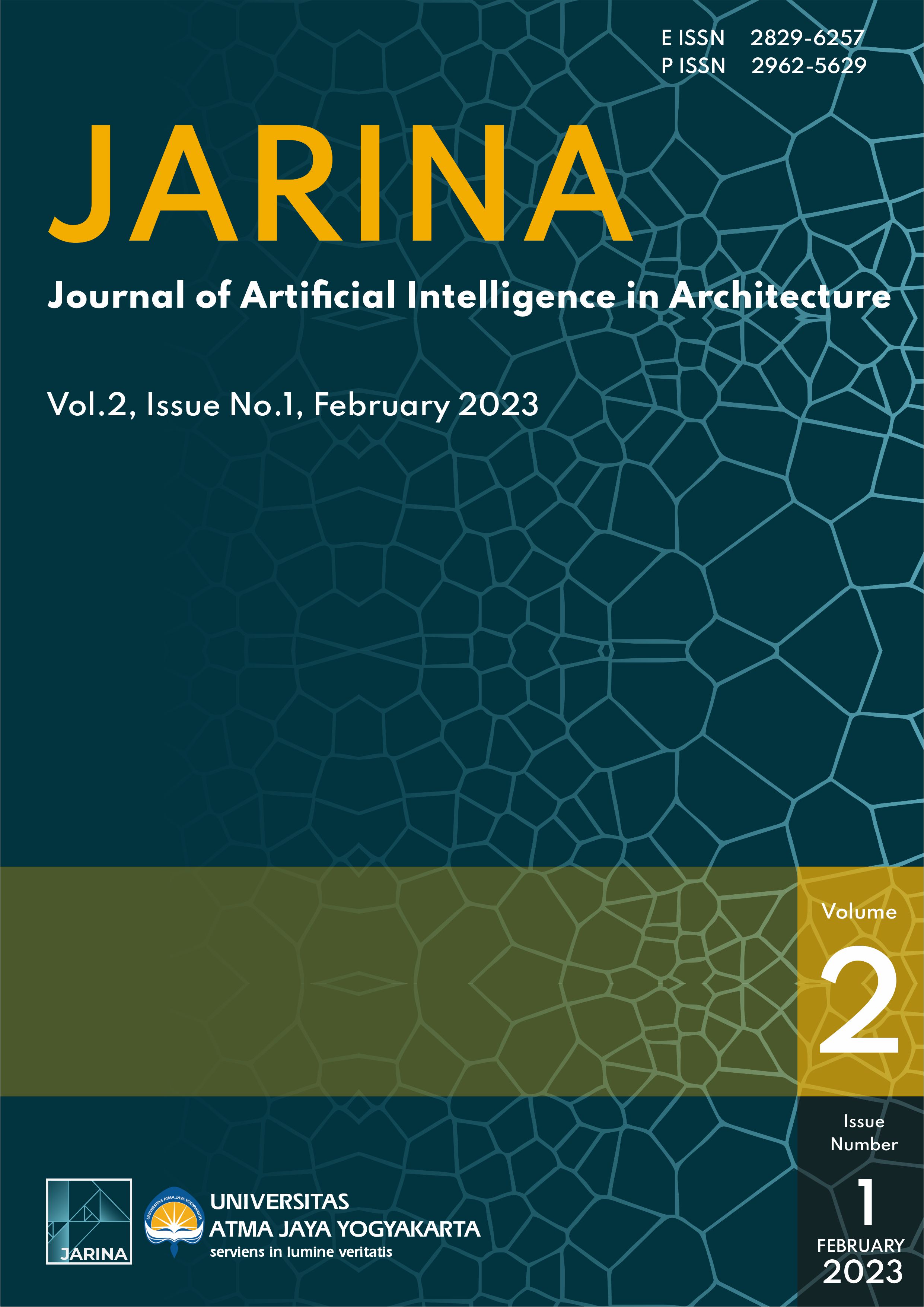Measuring Sustainability of Kampong Tudong Riverside Settlements Using Urban Modeling Interface Simulation
DOI:
https://doi.org/10.24002/jarina.v2i1.6494Keywords:
Riverside settlements, Floor area ratio, Daylighting, Operational energy, MobilityAbstract
Coastal settlements are the most vulnerable area to climate change, which has had an increasing impact on natural changes and human life in recent years. Therefore, sustainable riverside settlement models need to be developed by maximizing welfare with minimal environmental damage through modeling simulations that can help understand, compare and evaluate buildings and settlements. Simulation of Kampong Tudong on the banks of Kapuas River used Urban Modeling Interface to analyze the floor area ratio, daylighting, operational energy, and mobility. The simulation results show values of 0.21 on Floor Area Ratio, 30% on average natural resources for building daylighting, 86 kWh/m2year on operational energy, and 66 on mobility. Meanwhile, the efficient standard values are <3.2 on FAR, 55% on average daylighting, 10.08-30 kWh/m2.year on operational energy, and 90-100 on mobility. Existing simulation values indicate that these values can still be improved and maximized further for the sustainability of the riverside settlements.
References
Conservation International, “Climate Change : 11 Facts You Need to Know,” 2021. https://www.conservation.org/stories/11-climate-change-facts-you-need-to-know#references
DARA and the Climate Vulnerable Forum, “CLIMATE VULNERABILITY MONITOR A GUIDE TO THE COLD CALCULUS OF A HOT PLANET 2 ND EDITION,” SPAIN, 2012.
Dirjen Pengendalian Perubahan Iklim, “Mengenai Perubahan Iklim,” 2017. http://ditjenppi.menlhk.go.id/kcpi/index.php/info-iklim/perubahan-iklim (accessed Nov. 21, 2021).
E. Nurhidayati and et. al., “Prediksi Perkembangan Lahan Permukiman Terhadap Kerentanan Bencana Banjir dan Kebakaran di Permukiman Tepian Sungai Kapuas Kota Pontianak,” Jurnal Tataloka, vol. Volume 18, pp. 249–260, 2016.
United Nations, “UNITED NATIONS FRAMEWORK CONVENTION ON CLIMATE CHANGE,” 1992.
Pemerintah Kota Pontianak, “Kondisi Geografis Kota Pontianak,” 2019. https://www.pontianakkota.go.id/tentang/geografis
A. Kusumawanto and Z. B. Astuti, Arsitektur Hijau Dalam Inovasi Kota. Yogyakarta: Gadjah Mada University Press, 2014.
Y. Matsufuji, “SUSTAINABLE HABITAT IN ASIA-A SITUATIONAL ANALYSIS,” Kyushu, Japan, 2004.
J. Coplak and P. Raksanyi, Planning Sustainable Settlements. Bratislava: Slovak University of Technology, 2003.
T. Karyono, Green Architecture in The Introduction to Understanding Architecture Indonesia. Jakarta: Rajawali Pers, 2010.
MIT Sustainable Design Lab Revision, “Learn UMI,” 2017. https://umidocs.readthedocs.io/en/latest/docs/examples/_tutorials.html
M. Anugraha, A. Kusumawanto, and M. Krisnany, “SUSTAINABLE DEVELOPMENT FOR THE CENTER OF SMALL CITIES,” JARS, pp. 11–16, 2018, [Online]. Available: https://www.
A. Dawudo and A. Cheshmehzangi, “Impact of Floor Area Ratio (FAR) on Energy Consumption at Meso Scale in China: Case Study in NIngbo,” in The 8th International Conference on Applied Energy - ICAE2016, 2017, pp. 3449–3455.
S. Fairuz, S. Fadzil, A. Abdullah, W. Mariah, and W. Harun, “THE IMPACT OF VARIED ORIENTATION AND WALL WINDOW RATIO (WWR) TO DAYLIGHT DISTRIBUTION IN RESIDENTAL ROOMS,” in CIBW 107 International Symposium on Construction in Developing Economies: Commonalities Among Diversities, 2013, pp. 478–485.
T. Dogan and Y. C. Park, “Testing the residential daylight score: Comparing climate-based daylighting metrics for 2444 individual dwelling units in temperate climates,” Lighting Research and Technology, vol. 52, no. 8, pp. 991–1008, Dec. 2020, doi: 10.1177/1477153520924838.
A. Zakiy, E. Djunaedy, and A. Suhendi, “Analisis Kecukupan Pencahayaan Alami Pada Ruang Pameran Bandung Technopark Sesuai Standar Dokumen IES-LM-83-12 Spatial Daylight Autonomy (sDA) dan Annual Sunlight Exposure (ASE),” in eProceedings of Engineering, 2019, pp. 4939–4945. [Online]. Available: https://openlibrarypublications.telkomuniversity.ac.id/
C. F. Reinhart, T. Dogan, A. Jakubiec, T. Rakha, and A. Sang, “UMI-AN URBAN SIMULATION ENVIRONMENT FOR BUILDING ENERGY USE, DAYLIGHTING AND WALKABILITY 2 3,” in 13th Conference of International Building Perfomance Simulation Association, 2013, pp. 476–483.
IKE, “Intensitas Konsumsi Energi.” 2015. Accessed: Nov. 10, 2021. [Online]. Available: https://www.scribd.com/doc/269401516/Intensitas-Konsumsi-Energi
Walkscore, “Walk Score Methodology,” 2021. https://www.walkscore.com/methodology.shtml (accessed Nov. 10, 2021).
Walikota Pontianak, Rencana Tata Ruang Wilayah Kota Pontianak Tahun 2013-2033. Indonesia, 2013.

Downloads
Published
How to Cite
Issue
Section
License
Copyright (c) 2023 Mutia Muyasarah, Arif Kusumawanto

This work is licensed under a Creative Commons Attribution 4.0 International License.
Authors who publish with this journal agree to the following terms:
1.Authors retain copyright and grant the journal right of first publication with the work simultaneously licensed under a Creative Commons that allows others to share the work with an acknowledgement of the work's authorship and initial publication in this journal.
2.Authors are able to enter into separate, additional contractual arrangements for the non-exclusive distribution of the journal's published version of the work (e.g., post it to an institutional repository or publish it in a book), with an acknowledgement of its initial publication in this journal.
3.Authors are permitted and encouraged to post their work online (e.g., in institutional repositories or on their website) prior to and during the submission process, as it can lead to productive exchanges, as well as earlier and greater citation of published work (See The Effect of Open Access).
















